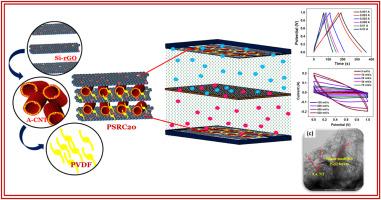Tuning the electrochemical performance of graphene via covalent surface functionalization using silane coupling agent and incorporation of acid-modified multi-walled carbon nanotube for high energy and high power supercapacitor application
IF 7.9
2区 工程技术
Q1 CHEMISTRY, PHYSICAL
引用次数: 0
Abstract
The covalent functionalization of the graphene surface is successfully employed using a silane coupling agent, 3-aminopropyl trimethoxy silane (APTMS). The silane modification increased the interlayer spacing between the rGO layers. The composite electrode loaded with 1.5 g APTMS displayed 97.3 % pseudocapacitance, implying the successful silylation of the oxygenated functional groups on the graphene structure. The silylation imparts a sheet-like internal morphology with sharp edges to rGO's morphology. Among binary electrodes, Si-rGO with 20 wt% loading of acid-treated multi-walled carbon nanotubes (A-CNT) (PSRC20 binary electrodes) show excellent electrochemical properties and the highest specific capacitance. PSRC20 binary electrode displayed 82.6 % pseudocapacitance. A uniform dispersion of A-CNT in the silane-modified rGO matrix is revealed in the TEM micrographs. A specific capacitance of 225.8 F/g is obtained for the aqueous symmetric supercapacitor assembled using the PSRC20 binary electrode. Cycling performance evaluation over 2000 charge-discharge cycles at a current of 0.03 A showed that the device maintained 95 % of its initial capacitance and achieved a coulombic efficiency of 98 %. The perceived specific energy and specific power are 31.4 Wh/kg and 1714 W/kg at a current of 0.03 A. The fabricated pseudocapacitor is highly efficient in high-current applications, providing high energy density.

通过硅烷偶联剂的共价表面功能化和酸修饰多壁碳纳米管的掺入来调节石墨烯的电化学性能,用于高能高功率超级电容器的应用
用硅烷偶联剂3-氨基丙基三甲氧基硅烷(APTMS)成功地实现了石墨烯表面的共价功能化。硅烷改性增加了氧化石墨烯层间的层间距。负载1.5 g APTMS的复合电极显示出97.3%的赝电容,这表明氧化官能团在石墨烯结构上成功实现了硅基化。硅基化使氧化石墨烯的内部形态呈片状,边缘锋利。在二元电极中,负载20 wt%酸处理多壁碳纳米管(PSRC20二元电极)的Si-rGO表现出优异的电化学性能和最高的比电容。PSRC20二元电极的赝电容为82.6%。透射电镜显示,A-碳纳米管在硅烷修饰的还原氧化石墨烯基体中均匀分散。使用PSRC20二元电极组装的水对称超级电容器的比电容为225.8 F/g。在0.03 a电流条件下,经过2000次充放电循环后的循环性能评价表明,该器件保持了95%的初始电容,库仑效率达到98%。在0.03 a电流下,感知比能量为31.4 Wh/kg,比功率为1714 W/kg。制备的伪电容器在大电流应用中效率高,能量密度高。
本文章由计算机程序翻译,如有差异,请以英文原文为准。
求助全文
约1分钟内获得全文
求助全文
来源期刊

Journal of Power Sources
工程技术-电化学
CiteScore
16.40
自引率
6.50%
发文量
1249
审稿时长
36 days
期刊介绍:
The Journal of Power Sources is a publication catering to researchers and technologists interested in various aspects of the science, technology, and applications of electrochemical power sources. It covers original research and reviews on primary and secondary batteries, fuel cells, supercapacitors, and photo-electrochemical cells.
Topics considered include the research, development and applications of nanomaterials and novel componentry for these devices. Examples of applications of these electrochemical power sources include:
• Portable electronics
• Electric and Hybrid Electric Vehicles
• Uninterruptible Power Supply (UPS) systems
• Storage of renewable energy
• Satellites and deep space probes
• Boats and ships, drones and aircrafts
• Wearable energy storage systems
 求助内容:
求助内容: 应助结果提醒方式:
应助结果提醒方式:


